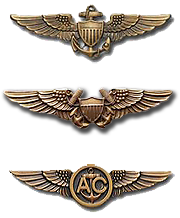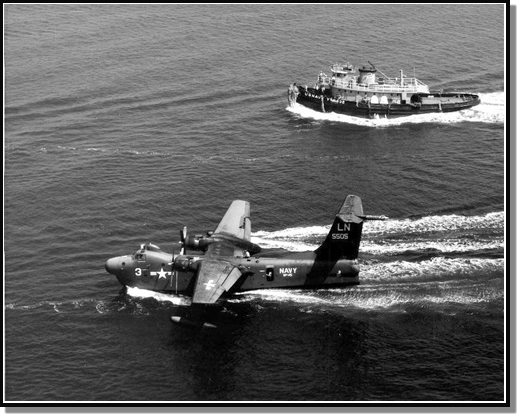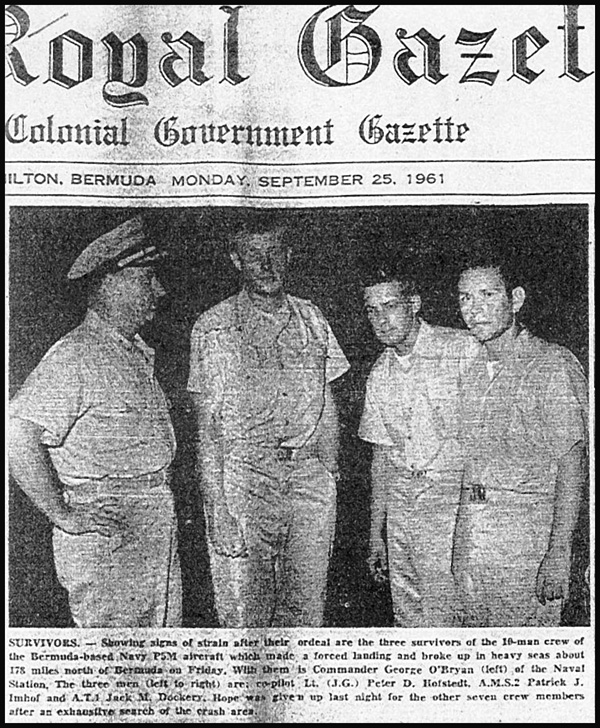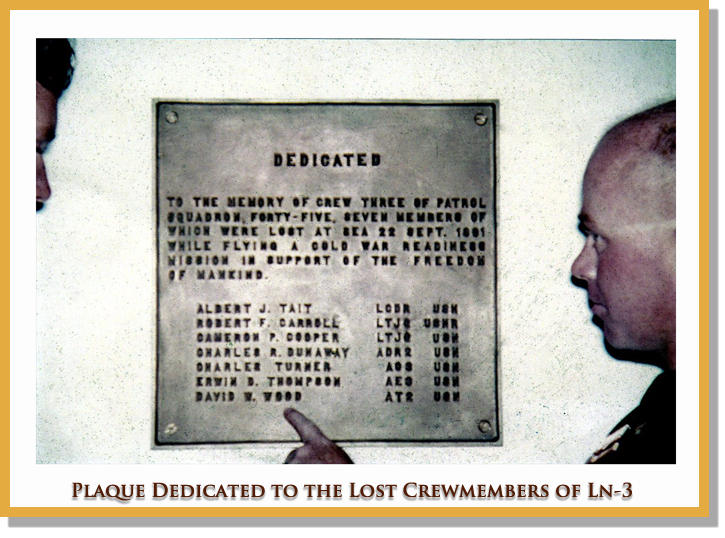LN-3 (P-5M) Crashes - 1961

Pages extracted from the winter 1961 edition of FARRELL LINES NEWS describing SS AFRICAN PILOT’S rescue operation of three U.S. Navy VP-45 personnel on September 23-24, 1961
Hurricane Esther’s grey clouds covered the September 21 departure from New York of the S.S. AFRICAN PILOT on voyage #57 out, destination: Monrovia.
Saturday morning, the 23rd, the PILOT was about 120 miles off the coast of Bermuda and still in stormy waters when it received a startling message: "We have aircraft in trouble in that vicinity..." At the urgent request of the Coast Guard, the PILOT’s Captain, Arthur M. Knight, diverted and proceeded to the scene of the crash to assist in the rescue operation. The heavy seas complicated the task, and the Captain and several crew members acted at great danger and risk to themselves. They finally succeeded in taking the only 3 members of the 10 man crew to survive aboard ship.
The entire story is described clearly and dramatically in Captain Knight’s report which follows.
Re: RESCUE OPERATION 23 SEPTEMBER 1961
Dear Mr. Lee: (Note: Commander A.S. Lee, a member of our association, was the CO of VP-45 at the time)
In order that you will have a clear picture of the subject rescue operation, I will endeavor to relate all the details in the following report. In order to avoid confusion, all times given will be Eastern Daylight Time which is also Bermuda Local Time.
As you know, I delayed our sailing from New York until 1500 on Thursday 21 September because of the hurricane that was passing the New York area. After leaving the 33rd Street Pier, Brooklyn, shortly after 1500, we proceeded to "Ambrose" to adjust the magnetic compasses and after which I took departure for Monrovia. Due to the reported sea conditions, offshore, I chose to run southeast around the bottom of the reported gales from hurricane "Esther" and therefore ease the ship and make better speed in a direction away from the disturbance. As the sea moderated I kept hauling more to the eastward toward Monrovia. At 1520 on Friday, 22 September, I held a Fire and Boat Drill, but due to heavy seas the boats were not swung out. The motors were operated and all emergency equipment was found in good condition. 
At 0135 on Saturday, 23 September, the Radio Officer, Mr. Francis M. Carey, was called by the Third Officer, Mr. E.E. Jouett, to send the regular 0600Z Observer message. Mr. Carey contacted radio station N O C, located at Bermuda, and transmitted the weather observer message and the U.S.C.G. AMVER message number 2. Upon receipt of these two messages, at 0144, the Bermuda Coast Guard Detachment called the African Pilot and said, "we have an aircraft in trouble in that vicinity and thought to be down" ...0155 Bermuda Coast Guard said, "We have plane looking for distressed plane; they sighted some flares."
At 0202 the following message was received; "MASTER AFRICAN PILOT WPEQ REQUEST YOU PROCEED TO POSITION 35-00 NORTH AND 65-10 WEST STOP NAVY AIRCRAFT HAS DITCHED WITH PERSONNEL IN THE WATER STOP COMMANDING OFFICER USCG AIR DETACHMENT BERMUDA". By the time that this message was received the Third Officer had called me, and I was on the bridge awaiting any further information. At 0219 I sent the following message to the commanding Officer USCG Air Detachment Bermuda: "ALTERED COURSE TO 085 TRUE EXPECT TO BE IN AREA OF 35 POINT ZERO ZERO NORTH AND 65 POINT 10 WEST AT 0600 STOP WILL MAINTAIN CONSTANT RADIO WATCH". The Coast Guard then advised us that they had two aircraft at the scene of the crash.
After sending the 0219 message I sent for the Chief Officer, Mr. T. F. Sterling, and outlined our approach to any possible rescue. The Chief Engineer was also informed of the plane crash and the fact that we were on our way to the area. During the next three hours the Chief Officer, Boatswain, Deck Men, the 4-8 watch and the 12-4 watch made extensive preparations on deck for any rescue activity. The lifeboat covers were removed and the lifeboats made ready for launching. The First Assistant Engineer, Mr. Stowell, and the Third Assistant Engineer, Mr. Hanlon, checked the lifeboat motors and kept same warmed-up for any possible use. Additional lookouts were posted on the bow and flying bridge, and the 18" searchlight was uncovered and tested. Cluster lights lined the side of the hull and were ready for immediate use. The Chief Officer and his rescue squad lined the outside of the ship in way of number three hatch with all available manila cargo nets. These nets ran from the rail to the water’s edge. The pilot ladders and the Jacob’s ladders were rigged outside the cargo nets. A total of 8 "safety belts" were laid out, each with a 60 foot length of 2 inch manila line attached. Heaving lines and life rings with painters were also on hand. The ship’s hospital was checked for proper equipment, towels, blankets and an extra supply of bedding. A supply of bath towels were heated and ready for immediate use. Two pistols were laid out to shoot at sharks if found necessary, and the engine room was kept on standby. The radio telephone was placed in service and the 2182 KC frequency was guarded.
At 0620 I sent the following message to COMMANDING OFFICER USCG AIR DETACHMENT BERMUDA, "MY DR POSITION IS 35 NORTH 65 POINT 10 WEST STOP NO SIGHT OF WRECKAGE OR SEARCH PLANES ADVISE." Between 0620 and 0630 I made radio phone contact with USCG aircraft #1272 on 2182Kc, and the pilot of the plane advised that he hadn’t seen any survivors or wreckage, but that there were two empty life rafts about two miles away on our starboard bow and requested that we recover or sink said rafts so that there would be no unnecessary confusion during search operations.
At about 0710, proceeding to the area where USCG plane reported empty rubber life rafts, three survivors were spotted in the water about 700 yards away. The wind at this time had freshened to about force 6; the sea was running about 20 to 30 feet in height and it started to rain very heavily. The engine was turning 40 rpm and I maneuvered the ship to leeward of the survivors and approached them within 40 feet. The three survivors had held on to each other since they came to the surface over 13 hours before our sighting them. When the ship was close to the survivors, heaving lines were stretched to them and they were hauled to the starboard side, in the way of number 3 hatch. When the three survivors reached the cargo nets, the ship was very slowly maneuvered to make some sort of a lee so that the men could be recovered from the water.
Before the lines could be secured to the survivors, one of them lost hold alongside the ship and rapidly drifted away. Due to the wind and heavy rain and the fear of losing sight of this man, I called the Coast Guard search plane overhead and asked them to drop a dye marker and flare close to this lone man in the water. The Coast Guard plane complied, and the survivor managed to keep close to the dye marker. At this time the immediate problem was to recover the two men alongside the ship. Clyde Clark, Boatswain, and Juan Landron, Deck Maintenance, without hesitation, put on safety belts and scrambled down the outside of the ship, with lines, and prepared the two survivors for hoisting aboard. Both Clark and Landron were working in the water. Mr. John Nathan, Second Officer, wearing a safety belt, went down the outside of the ship to assist, but he was not in the water. The entire crew, with the exception of the watch in the engine room, were on deck assisting to the best of their abilities. The first survivor landed on deck was Jack M. Dockery, AT1 U.S.N., the second man brought aboard was LTJG P. D. Hofstedt, USN, copilot of the ditched plane. Immediately upon landing on the deck, the survivors were taken to the ship’s hospital, undressed and dried with warm towels, and wrapped in blankets and put to bed.
Now the next order of business was to recover the third man in the sea. I tried to maneuver the ship in such a position that I could pick up the third survivor in the same manner as the first two and thus eliminate the necessity of launching a lifeboat under very unsatisfactory sea conditions, but this was impossible due to the wind and sea conditions. The Coast Guard plane, overhead, called me on the radiophone and said: "That man in the water is being attacked by sharks." At his time I could hear the man in the water screaming: "Sharks! Sharks! Please help me, get me out of the water!" I then backed and filled and made the best "lee" that I could under the conditions, and ordered lifeboat number two launched at about 0825. This boat was under the command of T.F. Sterling, Chief Officer. The lifeboat was launched without incident and picked up PATRICK J. IMHOF, AMS2, the third survivor, about 5 minutes later.
Imhof was attacked by sharks during the rescue operations and was bitten about three times on his back. During the time that the lifeboat was away, I worked to get in position to recover the lifeboat as quickly and as safely as possible. When the lifeboat returned alongside the ship, heavy bow and stern lines were made fast in order to steady the boat during hoisting. Lifelines and man ropes were employed and, at an opportune moment, the falls were hooked up and the boat recovered without incident at about 0905.
After the three rescued men were taken care of, the Coast Guard plane asked to talk directly with anyone of the survivors in order to obtain information to be used in search planning. AT1 Jack M. Dockery was able to talk to the Coast Guard plane and he told them that the plane crashed about 1810 on Friday evening, after loosing number 2 engine and the AC power on the number 2 bus. Dockery also said that they attempted to drop the bomb bay tank, but the power loss prevented this drop. The bomb bay doors would not close and the plane was only 300 feet above the surface. The plane crew were in the process of closing the bomb bay by hand when the plane hit the water.
According to the survivors, the plane broke up on impact. As far as he, Dockery, knew, he and Lt. Hofstedt and Imhof were the only men to get out of the plane. Dockery said that the plane didn’t stop when it hit the water but kept on going down. All three survivors said that they were about 40 feet down under the surface when they managed to get out of the wreck. Seven others apparently went to the bottom with the plane. The third man to be rescued was Patrick J. Imhof. He was the one who broke loose from the ship and was being attacked by sharks while we were recovering the first two men. The shark bites received by Imhof were minor, but it made me shudder every time I looked at the slashes in his back and left arm. The Chief Officer patched up all wounds, shark bites, etc., and gave the survivors some hot tea and advised them to sleep for a few hours.
but kept on going down. All three survivors said that they were about 40 feet down under the surface when they managed to get out of the wreck. Seven others apparently went to the bottom with the plane. The third man to be rescued was Patrick J. Imhof. He was the one who broke loose from the ship and was being attacked by sharks while we were recovering the first two men. The shark bites received by Imhof were minor, but it made me shudder every time I looked at the slashes in his back and left arm. The Chief Officer patched up all wounds, shark bites, etc., and gave the survivors some hot tea and advised them to sleep for a few hours.
In the meantime, search operations were continuing for any other survivors. About the time that the third man was rescued, a submarine, the USS CORPORAL appeared on the scene. A Coast Guard Cutter reported that he would be at the scene about 1150 and a Canadian warship, COLUMBIA, was also enroute to the area to assist in the search. At 1031 the AFRICAN PILOT was released by USCG search plane #1272 and I was requested to land the survivors at Bermuda. Upon release by USCG Aircraft #1272, this unit steamed for Bermuda which was some 180 miles to the south. At noon all the survivors ate a hearty meal and all claimed to feel much better. During the afternoon all three rescued men were showered and cleaned up and each issued a set of clothing from the slop chest. This included shoes, socks, underwear, khaki pants, khaki shirts, handkerchiefs and web belts. We arrived at Bermuda Saturday evening at 2230 and picked up the pilot who anchored the ship outside of the entrance channel as there is no night navigation in the channel. The agent, having been advised by Mr. James Farrell, boarded the ship with a Customs Officer and a U.S. Navy Flight Surgeon who examined the survivors and found them fit to leave the ship via the accommodation ladder to the launch. The Customs Officer entered and cleared the ship and we departed for Monrovia at 0030 Sunday, 24 September. Upon leaving the vessel, all three survivors praised the rescue work by the ship’s company and praised the food, and all were profoundly thankful. One of the lads said that he would always ship via Farrell Lines.
During the search and rescue operation, the entire ship’s company were on hand to assist in any way possible. There were times when we had as many as 30 lookouts posted --75% self-appointed. The performance of the Officers and crew was highly commendable and a credit to the ship and to the company.
Amazing story of the rescue of three sailors. One of those rescued, PJ Imhof, is a member and officer of our association. Webmaster
FLOWERS DROPPED IN OCEAN WHERE NAVAL FLYERS LOST LIVES
(Hamilton Bermuda Royal Gazette - September 1961)
Large baskets of white flowers were dropped into the sea yesterday over the spot 178 miles north of Bermuda where seven men of Patrol Squadron 45 at the United States Naval Station lost their lives last Friday when their P5M-2 patrol plane was forced to make a crash landing. Before the flowers were dropped into the sea they had been on the altar in the Chapel of Peace at the Naval Station, where, in the morning, two moving and very well attended memorial services were held for the seven men.
Address by Alan S. Lee, Commanding Officer
"Seven of the most wonderful shipmates anyone has ever had have been called by God Almighty to join Him in His Paradise of Heaven. Their departure has brought us great sorrow because we leaned on them and needed their help. These men were not defeated by long hours of boredom and routine. They were challenged by it. They provided protection to the many and security to the United States by flying  through days and nights of hazardous skies and observing silent, unfriendly waters. The mission to which they gave their lives is not yet ended, the threat to peace and freedom is ever present.
through days and nights of hazardous skies and observing silent, unfriendly waters. The mission to which they gave their lives is not yet ended, the threat to peace and freedom is ever present.
It is now for us, their shipmates, to dedicate ourselves to continue this arduous task of protecting the United States and all her people. The loved ones who have been left to mourn, now have the most difficult task of all: learning to adjust to life without the love and comfort of these, our honored dead.
We extend to all of them our heartfelt sympathy, our love and understanding, and our unstinting help."
The three men picked up by the merchant ship were the only survivors of the ten man LN3 P-5 aircrew. Association members that were in Bermuda at the time of the accident were all deeply affected by the tragic loss of their shipmates and friends. Patrick (PJ) Imhof lives in Pensacola, FL with his wife Eileen. He is an active member of the Patron Four Five Association and works part time at the Naval Air Museum. He stays in contact with Pete Hofstedt who lives in New York. Jack Dockery was killed in a car accident a few years ago. ED
Send questions, comments or suggestions regarding this website to: vp45assoc@vp45association.org
Copyright © 2005 PATRON FOUR FIVE ASSOCIATION


